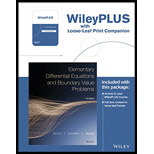
(a)
The approximate values of the solution of initial value problem
(b)
The approximate values of the solution of initial value problem
(c)
The approximate values of the solution of initial value problem
(d)
The solution
Want to see the full answer?
Check out a sample textbook solution
Chapter 2 Solutions
Elementary Differential Equations And Boundary Value Problems
- Let G be a connected graph with n ≥ 2 vertices. Let A be the adjacency matrix of G. Prove that the diameter of G is the least number d such that all the non-diagonal entries of the matrix A are positive.arrow_forwardfind the general soultion (D-DxDy-2Dx)Z = sin(3x+4y) + x²yarrow_forward3. Show that (a) If X is a random variable, then so is |X|;arrow_forward
- 8. [10 marks] Suppose that 15 people are at a dinner and that each person knows at least 9 of the others. Can the diners be seated around a circular table so that each person knows both of their immediate neighbors? Explain why your answer is correct.arrow_forwarddx Y+2 h dy x + Z " dz X+Z find three Soultion indeparedarrow_forward(b) State Fubini's Theorem without proof. Theorem to demonstrate thatarrow_forward
- (b) Define a simple random variable. Provide an example.arrow_forward19. Let X be a non-negative random variable. Show that lim nE (IX >n)) = 0. E lim (x)-0. = >arrow_forward9. [10 marks] Consider the following graph G. (a) Find the Hamilton closure of G. Explain why your answer is correct. (b) Is G Hamiltonian? Explain why your answer is correct.arrow_forward
 Discrete Mathematics and Its Applications ( 8th I...MathISBN:9781259676512Author:Kenneth H RosenPublisher:McGraw-Hill Education
Discrete Mathematics and Its Applications ( 8th I...MathISBN:9781259676512Author:Kenneth H RosenPublisher:McGraw-Hill Education Mathematics for Elementary Teachers with Activiti...MathISBN:9780134392790Author:Beckmann, SybillaPublisher:PEARSON
Mathematics for Elementary Teachers with Activiti...MathISBN:9780134392790Author:Beckmann, SybillaPublisher:PEARSON
 Thinking Mathematically (7th Edition)MathISBN:9780134683713Author:Robert F. BlitzerPublisher:PEARSON
Thinking Mathematically (7th Edition)MathISBN:9780134683713Author:Robert F. BlitzerPublisher:PEARSON Discrete Mathematics With ApplicationsMathISBN:9781337694193Author:EPP, Susanna S.Publisher:Cengage Learning,
Discrete Mathematics With ApplicationsMathISBN:9781337694193Author:EPP, Susanna S.Publisher:Cengage Learning, Pathways To Math Literacy (looseleaf)MathISBN:9781259985607Author:David Sobecki Professor, Brian A. MercerPublisher:McGraw-Hill Education
Pathways To Math Literacy (looseleaf)MathISBN:9781259985607Author:David Sobecki Professor, Brian A. MercerPublisher:McGraw-Hill Education





